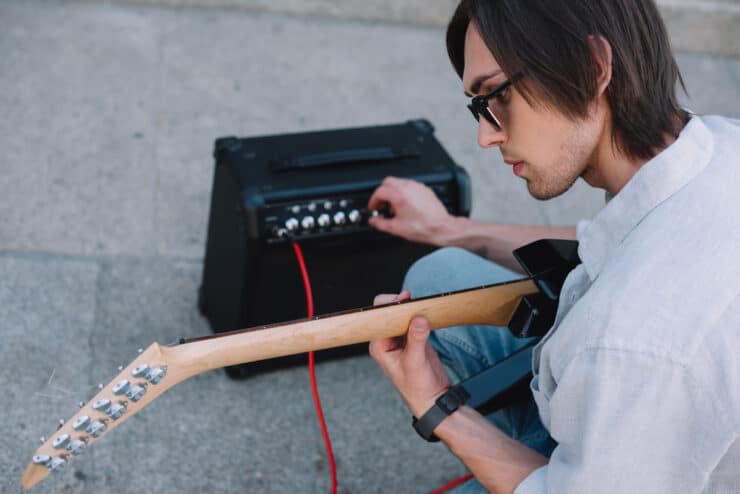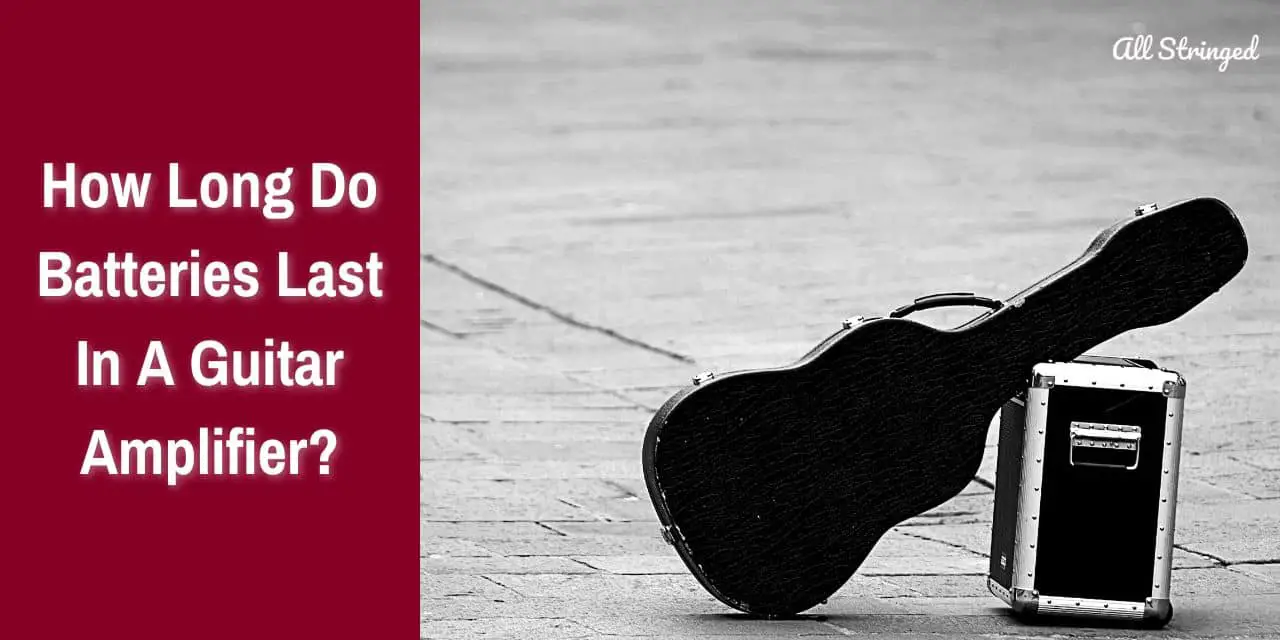Are you a guitar player who loves to play with a guitar amplifier but don’t know how long your battery life lasts? You are not alone! Many guitar players have the same question about their battery life. In this article, we will provide answers to this common question and help you better understand the battery life of your guitar amplifier. Read on to find out more and get tips on how you can make the most out of your battery life.
What are guitar amplifiers?
In the world of music, the guitar holds a significant place as it is one of the most versatile and beloved instruments. To unleash the full potential and power of guitars, guitarists rely on a crucial piece of equipment known as the guitar amplifier. A guitar amp is an electronic device that amplifies the electronic signal generated by the guitar’s pickups, transforming it into the captivating sound that is associated with the instrument.
>>> Click here to read our review about the Top 15 Best Battery-Powered Guitar Amps <<<
A guitar amp, short of a guitar amplifier is a device used for amplifying the signal produced by an electric or acoustic-electric guitar. When a guitarist strums or plucks the strings, the guitar’s pickups convert the vibrations into an electrical signal. This weak electrical signal then gets sent to the guitar amplifier, which boosts its strength and shapes the sound before sending it through the speaker. Guitar amps play a crucial role in not only increasing the volume of the guitar amp but also enhancing its tonal qualities, giving it the characteristic warmth and distortion that is a hallmark of electric guitar music.
Here are the different types of guitar amplifiers available in the market –
Tube amplifiers
Tube amplifiers or also known as valve amps are revered for their warm and rich sound, making them a favorite among many guitarists. These guitar amps make use of vacuum tubes to amplify the guitar signal. Tube amps produce natural, harmonic overtones and respond dynamically to the player’s touch, making them highly expressive. However, they tend to be heavier, more expensive, and require occasional maintenance such as tube replacement.

Solid-state amplifiers
Solid-state amplifiers use semiconductor devices like diodes and transistors to amplify the guitar signal. They are generally more affordable, lighter, and required less maintenance compared to tube amps. Solid-state amps are known for their clarity and reliability. They provide a clean and more precise sound, which makes them suitable for music genres where a transparent tone is desired, such as country or jazz.
Digital modeling amplifiers
Digital modeling amplifiers are digital amps that make use of digital signal processing (DSP) technology for emulating the sound of various classic and modern amp models. They can simulate the tone of different tube amps, solid-state amps, and even vintage classics. They offer a wide range of tones and effects, which makes them quite popular for recording and live performances as they can replicate the sound of multiple amps in one unit.
Hybrid amplifiers
Hybrid amplifiers combine the best of both worlds, featuring both tube and solid-state circuitry. They typically make use of a tube preamp section for warmth and a solid-state power amp section for efficiency. Hybrid amps offer a compromise between the tonal characteristics of tube and solid-state amps, providing a blend of warmth and clarity.
How long do batteries last in a guitar amplifier?
If you’re a beginner musician or guitarist looking to buy a new guitar amp, one of the doubts you may have would include the battery. It is common to wonder how long do batteries last in a guitar amplifier. A guitar preamp’s battery typically lasts between 40 and 80 hours. The length of time the battery lasts will depend on the brand of battery you’re using, the type of preamp, and how often you’re using the preamp. To get the most life out of the guitar preamp’s battery, it is important to follow the manufacturer’s recommendations for charging and storing the battery.
Guitar amp batteries typically last between 4 and 6 hours. How long do batteries last in a guitar amplifier will depend on the brand, size, and power of the amp’s battery. If you are using your guitar amplifier for practice, you will probably be able to get away with a shorter battery life. However, if you are using your guitar amp for gigs, you will want to make sure that you’ve got a battery that will last through the entire performance.
Moreover, a guitar amp’s battery life will also vary depending on how much you’re playing. Further, if the guitar amp is not being used, leaving it plugged in will end up shortening its battery life. If the battery in the guitar amplifier is not kept charged, you can take some simple steps to extend its life. A decent 9V battery can easily last up to 100 hours or more depending on how well it is being used. The battery will end up lasting longer if the battery is used less frequently. Moreover, you should keep in mind that a rechargeable battery or power adapter will end up being a lot more expensive compared to a non-rechargeable battery or power adapter.
The guitar pedal is important for a guitarist’s sound. The life of a battery is heavily affected by its milliamp-hour drain in each circuit. This affects the complexity of the effect. You can get up to 60 hours out of low-drain pedals like overdrives and almost 10 hours out of more complex modulation effects. The primary reason why most guitar pedals drain their batteries is that they’re designed to operate continuously. Dying batteries generally have a more noticeable impact on both the intensity of the LED and the tone of the lead.
For extending the life of a pedal’s battery, only use it when needed. Otherwise, the guitar pedal’s battery will end up draining excessively. You’ll be able to get a better sound out of the effects if you’ve got a battery.

Factors that affect the battery life of a guitar amp
Guitar amplifiers are essential tools that allow musicians to amplify and shape their sound. Many guitarists rely on portable, battery-powered guitar amps for their mobility and convenience. However, a common concern when using battery-powered guitar amps is the longevity of the battery life. Understanding the factors that influence battery consumption will be important for ensuring uninterrupted performance and practice sessions. Here are some of the key factors that affect the overall battery life of batteries in a guitar amp and how to maximize its usage.
#1. Battery type and capacity
The type of battery used in a guitar amp plays a key role in determining its lifespan. Common battery types include lithium, alkaline, and rechargeable batteries. Lithium batteries typically have a longer lifespan and better performance compared to alkaline batteries. Additionally, the capacity of mAh (milliampere-hour) rating of the battery affects how long it can power the amp. Higher-capacity batteries tend to last longer and provide more playtime.
#2. Amp power consumption
The power consumption of the guitar amp is an important factor in battery life. Amplifiers with higher power ratings typically consume more energy. Battery-powered guitar amplifiers with lower wattage or adjustable power settings can be more efficient in preserving battery life during prolonged use.
#3. Volume and gain settings
The volume and gain settings on the guitar amp directly impact power consumption. Playing at higher volumes or with increased gain levels draws more current than the battery, depleting its charge quicker. Lowering the volume and gain when not needed can help extend battery life significantly.
#4. Built-in effects and features
Many modern battery-powered guitar amplifiers come equipped with built-in effects, such as delay, reverb, and chorus. While these features enhance the sound, they also contribute to enhanced power consumption. Using effects sparingly or opting for a simpler setup can conserve battery life.
#5. Speaker size and efficiency
The size and efficiency of the speaker in the guitar amplifier can influence battery usage. Larger speakers or those with lower efficiency ratings might require more power to produce the desired volume, reducing battery life. Smaller and more efficient speakers can help conserve energy while maintaining suitable sound levels.
#6. Playing time and rest periods
The duration of continuous playing will directly affect the battery life. Longer playing sessions drain the battery more quickly. Taking breaks between practice or performances allows the battery to rest and recover, which can extend its overall lifespan.
#7. Ambient temperature
The ambient temperature in the environment can greatly impact battery performance. Batteries tend to discharge faster in cold temperatures while high temperatures might reduce their overall lifespan. Keeping the guitar amp at moderate temperatures can optimize battery efficiency.
How to calculate the battery life of a guitar amplifier?
For musicians and guitarists who rely on portable, battery-powered guitar amps, understanding the battery life is important for planning uninterrupted performances, rehearsals, or practice sessions. Calculating the battery life of a guitar amp will involve considering several factors. Here are the steps you should follow for calculating the battery life of the battery of a guitar amp, helping you optimize your musical experience.
Step 1: Identify the battery type and capacity
The first step in calculating the battery life of a guitar amp is to identify the battery type and its capacity in milliampere-hours (mAh). Common battery types include lithium, alkaline, and rechargeable batteries. The battery’s capacity ratings can usually be found on its label or packaging. For instance, a 9V alkaline battery typically comes with a capacity of 500mAh.

Step 2: Determine the amp power consumption
Next up, you should determine the power consumption of your guitar amplifier. This information can be easily found in the amp’s used manual or specifications. You should look for the amp’s power rating in watts or milliwatts (mW). For instance, an amp with a power rating of 5W consumes 5000mW of power.
Step 3: Calculate the current draw
For calculating the current draw of the guitar amplifier, divide its power consumption (in milliwatts) by the operating voltage. Most battery-powered guitar amps operate on a 9V battery, so in that case, you should divide the power consumption by 9V. For instance, a 5W amp will have a current draw of approximately 555.56mA (5000mW divided by 9V).
Step 4: Estimate the battery life
With the current draw calculated, you’ll be able to now estimate the battery life. Divide the battery’s capacity (in mAh) by the current draw (in mA) to determine how many hours the battery will last. For instance, if you have a 500mAh battery and the amp draws 555.56mA of current, the estimated battery life will be around 0.9 hours or approximately 54 minutes (500mAh divided by 555.56mA is approximately 0.9 hours).
Step 5: Consider real-world factors
While the above calculation offers an estimate of battery life under ideal conditions, real-world factors can influence the actual battery performance. Temperature, speaker efficiency, and playing habits (volume and gain settings) can impact battery life. In colder temperatures, batteries might drain faster while high volume and gain settings can increase power consumption. Be mindful of these factors when you’re planning your performances or practice sessions.
Step 6: Use rechargeable batteries
If you frequently use battery-powered guitar amps, consider investing in rechargeable batteries. Rechargeable batteries can be more cost-effective and environmentally friendly in the long run. Keep spare fully charged batteries on hand to ensure uninterrupted playtime.
Different types of batteries you can use in a guitar amplifier
For musicians and guitarists who prefer the freedom of portable playing on those seeking an alternative power source to electrical outlets, batteries play a key role in keeping the music flowing. Different types of batteries are commonly used in guitar amps, each offering unique advantages and considerations. Here are the different types of batteries used in guitar amps and their characteristics and suitability for powering your musical journey.
Alkaline batteries
Alkaline batteries are a widely available and economical option for powering guitar amps. They utilize an alkaline electrolyte that provides a reliable and steady power output. These batteries are commonly found in various sizes, including the popular 9V size used in many guitar amps.
Alkaline batteries are rather affordable and readily available in stores. These batteries are suitable for devices with moderate power requirements, which makes them suitable for smaller and lower-wattage guitar amps. Alkaline batteries have a long shelf life when stored properly, making sure that they retain their charge when not in use.
Alkaline batteries have a finite lifespan and are typically single-use, needing replacement once depleted. As single-use batteries, proper disposal or recycling practices are important to minimize environmental impact.
Lithium batteries
Lithium batteries are a more advanced and high-performance alternative to alkaline batteries. They use lithium as the active material, providing a higher energy density and longer-lasting power output. Lithium batteries are commonly available in 9V sizes and are used in various electronic devices, including some guitar amps.
Lithium batteries offer higher energy density, providing more extended playtime compared to alkaline batteries. These batteries are lighter than alkaline batteries, which makes them ideal for portable setups. Moreover, these batteries have a longer shelf life and retain their charge better during storage.
Lithium batteries are typically more expensive than alkaline batteries, which might be a consideration for budget-conscious musicians. Not all guitar amps are designed to use lithium batteries, so it is essential to check compatibility before use.
Rechargeable batteries
Rechargeable batteries or also known as secondary batteries offer a more sustainable and cost-effective solution for powering guitar amps. These batteries can be recharged and reused multiple times, which reduces the need for single-use batteries and minimizes waste.
Rechargeable batteries help reduce the environmental impact of disposable batteries. While rechargeable batteries might have a higher upfront cost, their reusability can lead to significant cost savings in the long run. Rechargeable batteries are available in various sizes and chemistries, including NiMH (Nickel-Metal Hydride) and Li-ion (Lithium-ion), which makes them suitable for different guitar amp models.
Rechargeable batteries require charging time, which might be a consideration for musicians who need immediate power. The capacity of rechargeable batteries might vary, so selecting batteries with sufficient capacity is essential for extended playtime.
Tips for extending the battery life of a guitar amplifier
Battery-powered guitar amps offer musicians with the flexibility and convenience to play music on the go, whether practicing, performing, or jamming with friends. However, maximizing the battery life of your guitar amplifier is important to ensure uninterrupted playtime and avoid unexpected power depletion during crucial moments. Here are some of the essential tips for extending the battery life of your guitar amp.
#1. Turn off the amp when not in use
One of the simplest yet most effective ways of preserving battery life is to turn off the guitar amp when it isn’t in use. When left powered on, even in standby mode, the amp continues to draw a small amount of current, gradually depleting the battery over time. Developing a habit of turning off the amp when you take a break from playing or after a performance can greatly extend the battery’s overall lifespan.
If you are using a battery-powered guitar amp during a gig or rehearsal with multiple breaks between songs, consider turning it off during those breaks to conserve power. A small LED indicator or power switch light can be an easy reminder for ensuring that the amp is switched off when not actively playing.
#2. Adjust the volume
The volume level at which you play your guitar amp will directly affect the power consumption and, subsequently, the battery life. Higher volume settings draw more current from the battery, resulting in faster depletion. To conserve power and extend battery life, you should consider adjusting the volume to a moderate or lower level while it isn’t necessary to play at full volume.
While playing at lower volumes might not have the same impact as a full-blown performance, it can be adventurous during practice sessions or intimate settings where excessive volume might not be required. You should keep in mind that most battery-powered amps can still produce satisfactory sound quality at moderate volume levels.
Moreover, you can also adjust the gain settings on the amp. Lower gain settings can reduce the power drawn by the amp while still allowing you to achieve a pleasant tone for your playing needs.
#3. Use high-quality batteries
Choosing high-quality batteries for your guitar amp can also impact the battery life. Premium batteries often have more consistent power output and can last longer compared to cheaper alternatives. While these batteries might have a higher upfront cost, their performance can result in cost savings in the long run due to their reliable power delivery and extended lifespan.
FAQs
How long do batteries last in a guitar amplifier?
The battery life of a guitar amplifier depends on a few factors, such as the type of amplifier and the power consumption of the device. Generally, a guitar amplifier will last anywhere from 4-6 hours on a single set of batteries. Some amplifiers may even have a battery indicator to help you determine when the batteries need to be replaced.
What type of batteries should I use in my guitar amplifier?
It is important to use the correct type of batteries for your guitar amplifier. Generally, alkaline batteries are the best choice for guitar amplifiers as they provide longer battery life and better performance. It is also important to use high-quality, name-brand batteries for optimal performance.
What can I do to extend the battery life of my guitar amplifier?
To extend the battery life of your guitar amplifier, you can reduce the power consumption of the device. For example, you can reduce the volume of the amplifier or turn off the device when not in use. Additionally, you can use rechargeable batteries, which can be recharged and reused multiple times.



